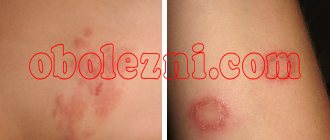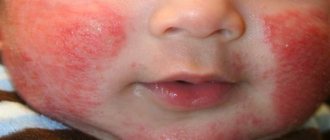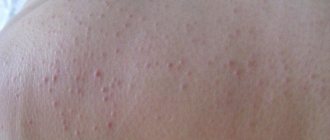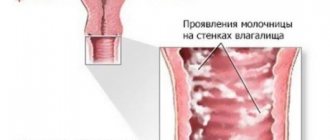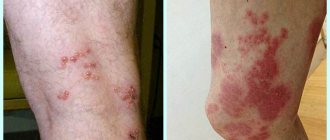The fungus that causes pityriasis versicolor is localized on the skin of every person. If a favorable environment is created for its reproduction, it provokes pathological changes in the epidermis. As a result, people are forced to take pills for pityriasis versicolor and use medications for external treatment of lesions. Regularity and consistency are extremely important in the treatment of this disease. Even a minor break in the therapy regimen will provoke the appearance of new multi-colored spots on the affected and clean areas of the skin.
The effectiveness of drug treatment
Treatment of versicolor versicolor requires patience from the patient, because in order to completely get rid of the rashes, it takes quite a lot of time.
Traditional methods of treatment, which involve the use of highly active drugs, are very effective, as they help eliminate the root cause of the disease and eliminate the external manifestations of the pathological process.
Important!
Treatment becomes effective only if medications are used correctly and the doctor’s recommendations are followed.
Prevention
For effective prevention of lichen, disinfection of personal belongings is indicated. This way you can avoid re-infection and prevent cases of relapse of the disease. Basic measures to prevent tubular lichen include:
- strict adherence to personal hygiene rules;
- use of individual washcloths, towels and skin care products;
- preference for clothing (especially underwear) made from natural fabrics, the ideal option is cotton;
- sun protection - the use of special means against excessive ultraviolet radiation;
- normalizing weight and treating excessive sweating, if such a problem exists;
- timely treatment of endocrine diseases and diseases of the gastrointestinal tract.
Methods for treating multi-colored skin dermatitis in humans
To treat lichen in adults and young patients, specialists usually prescribe several groups of drugs that have a complex effect on the body and speed up the healing process.
Antimycotic drugs
Antifungal drugs for external use in the form of ointments, gels or shampoos are highly effective against fungal diseases affecting the skin, nails and scalp.
Such remedies help cope with the infection both at the initial stage of development and at an advanced stage.
Antifungal tablets
They are used for lesions of large areas of the skin, as well as in combination therapy as an additional effect on the main source of infection .
If pityriasis versicolor is accompanied by a bacterial infection, the doctor may prescribe broad-spectrum antibiotics.
Antihistamines
They relieve symptomatic manifestations of allergies and prevent their occurrence when using various medications intended for the treatment of lichen.
Antiseptics
They exfoliate the stratum corneum of the epidermis affected by the fungus, soften the skin and relieve inflammation. Antiseptics can be in the form of solutions or mash for external use.
What is pityriasis versicolor and how can you get it?
Pityriasis versicolor is a harmless fungal disease that affects the skin. The causative agent of the disease is a yeast-like fungus. It is called Pityrosporum and has three forms:
- rounded;
- mycelial;
- oval.
In humans, round and oval-shaped mushrooms are found on the skin, but this does not necessarily result in lichen. Characteristic rashes on the surface of the epidermis will appear when these forms are transformed into mycelial.
Medical statistics indicate that the male part of the population is more susceptible to the disease. Most often, pityriasis versicolor is diagnosed in young people living in regions with humid and hot climatic conditions.
This chronic and often recurrent disease develops in people under the influence of the following external and internal factors:
- suffered stress;
- diabetes and other endocrine diseases;
- increased sweating;
- pathological processes in the gastrointestinal tract;
- immunodeficiency (during cancer and HIV therapy);
- decreased immunity;
- excess body weight;
- heredity.
The best drugs
Among the many drugs for the treatment of lichen versicolor, dermatologists identify a number of the safest and most effective drugs that have a positive effect on the outcome of the disease.
Mycozoral
An antimycotic agent in the form of an ointment that suppresses the development and spread of pathogenic flora to healthy tissue. The ointment is applied in a thin layer to the affected areas and quickly eliminates the rash.
Fluconazole
An antifungal drug in tablet form, the effect of which lasts for eight weeks. The medication is easily tolerated in a combined treatment regimen and rarely causes side effects.
Clotrimazole
Antifungal agent for external use. Clotrimazole is available in several pharmacological forms: solution, shampoo, tablets and ointment. Any selected product is used once a day.
Triderm
A combined drug in the form of a cream and ointment with antibacterial, anti-inflammatory, antiallergic and antifungal effects. Contraindications for use are children under two years of age and hypersensitivity to the components of the drug.
Nizoral
A synthetic broad-spectrum antifungal agent. You can buy Nizoral in the form of shampoo, cream or tablets.
Fungoterbin
Antifungal cream, which is applied strictly to previously cleansed skin once a day for two weeks. A special feature of the drug is the possibility of its use during pregnancy and for the treatment of young children.
Rumicosis
Medicinal antifungal drug in capsule form. The duration of treatment is 7 days. Children and pregnant women are prohibited from using the drug.
Bifonazole
Ointment for the treatment of fungal diseases. The product can be used for 21 days, after which treatment should be stopped. Bifonazole is available in the form of a solution, cream and powder.
Griseofulvin
Antifungal antibiotic in tablet form. The drug is prescribed exclusively for the treatment of dermatological diseases. It is prohibited to take this medicine as a preventive measure.
Ciclopirox
Synthetic antifungal drug (cream and ointment) for local dermatological treatment. The duration of therapy is a maximum of 10 days.
Sebozol
An external medicinal product with an antifungal effect, used not only in the treatment of pityriasis versicolor, but also to combat seborrheic dermatitis.
Personal hygiene
Treatment will be ineffective if the patient’s bed linen and clothing are not disinfected. During the course of taking antifungal drugs, bed linen is washed at 90 degrees. In addition, grated laundry soap is poured into the drum of the washing machine.
Linen must be changed daily; you cannot share a sleeping set with other family members during treatment. During treatment, you should try to wear only things made from natural fabrics, avoid hypothermia and overheating of the body. It is necessary to exclude hard work and psychological stress that lead to exhaustion of the nervous system.
Before going outside in extreme heat, it is better to first treat the affected skin with table vinegar, salicylic acid, and an alcohol solution of iodine. This will prevent the active proliferation of fungi under the influence of heat.
Aids
To enhance the therapeutic effect, doctors prescribe additional treatment methods and products that have a beneficial effect on the skin.
Boric acid
An antiseptic solution that has a pronounced bactericidal, disinfectant and anti-inflammatory effect. The drug quickly penetrates the inflammatory focus, so the first results can be seen after just a few days of use .
Phytotherapy
A treatment method based on the use of medicinal plants. Like any medicine, herbal medicines have a number of contraindications and side effects, for this reason their use should be agreed with the attending physician.
Antifungal shower gels
They prevent the spread of fungus and complement the main drug treatment well. It is not advisable to use such gels daily; 2-3 times a week is enough.
Diagnostics
The diagnosis of pityriasis versicolor is made on the basis of the characteristic appearance of the spots, as well as several tests that make it possible to distinguish the disease from others with similar clinical manifestations, such as vitiligo, pityriasis alba or pink, psoriasis, seborrheic dermatitis, dermatophytosis of the trunk, eczema, cutaneous syphilis.
Currently, the following diagnostic tests are carried out to clarify the diagnosis of pityriasis versicolor and distinguish it from other diseases with similar manifestations:
- Microscopy of scrapings from spots - when examining under a microscope the scales pre-treated with a 20% KOH solution, in pityriasis versicolor, threads of the fungal mycelium and the yeast cells themselves are visible in the form of a characteristic picture with the figurative name “navy pasta”. This means that the mycelium of the fungus appears as long strands, between which are dark, round yeast fungal cells. That is, in total, white strands and dark rounded pieces between them are visible in the microscope, which is reminiscent of the appearance of the dish “naval pasta”;
- Iodine test - spots and surrounding skin are treated with a 5% iodine solution and after a few minutes the intensity of the color is recorded. Pityriasis versicolor spots are dark brown, and their color is much more intense than the surrounding normal skin;
- Examining the spots in the light of a Wood's lamp - with pityriasis versicolor, the spots glow reddish-yellow or greenish-golden;
- Positive “chips” symptom (Bernier’s sign) – when the spot is scraped, peeling appears. The exfoliating particles are very small, similar to flour.
In the vast majority of cases, to diagnose pityriasis versicolor, it is sufficient to study the spots in the light of a Wood's lamp and an iodine test.
When can a disease not be treated with medication?
For the treatment of pityriasis versicolor, medications cannot be used only if the prescribed drugs contain components to which the patient is allergic.
To avoid an allergic reaction, the patient should carefully study the composition of the medicine and information about contraindications.
Important!
Before using any medications, you should make sure that you have the disease. To do this, you need to contact a dermatologist who will establish a diagnosis and prescribe the correct treatment.
Diet
When treating tubular lichen, you need to make some changes to your diet:
- exclude alcohol and carbonated drinks;
- limit the consumption of sugar, sweets, and baked goods;
- limit the amount of carbohydrates;
- exclude fried, fatty, spicy, smoked, pickled foods, hot spices;
- maintain a drinking regime, which should be based on clean water and green tea;
- ensure sufficient vitamins and minerals in the diet.
Symptoms
The main manifestations of tubular lichen are colored spots, other accompanying symptoms: itching, burning - appear very rarely. There may be a slight desire to scratch the damaged area, but it is not intrusive and is rather psychological in nature. When the disease relapses, diagnosis is greatly simplified. The exception is atypical cases of diseases and those complicated by lack of treatment and poor hygiene.
Rarely, tinea versicolor manifests itself on the limbs and head; its location is the torso and large areas of the arms and legs.
Causes
Young people under 30 years of age are at risk of developing tubular lichen. Fungi that provoke pathology are opportunistic, so certain factors are needed for the disease to occur:
- hyperhidrosis;
- decreased immunity;
- genetic predisposition;
- chronic stress;
- lack of hygiene;
- hypothermia;
- injuries and other damage to the skin;
- autonomic disorders;
- violation of the protective functions of the epidermis;
- abuse of bactericidal agents;
- wearing synthetic underwear and clothing;
- changes in the chemical composition of sweat (possibly when taking medications or working with chemicals);
- oily skin;
- hormonal imbalances (adolescence, pregnancy, menopause, taking hormonal medications).
Pathologies of a chronic nature can also provoke the development of tubular lichen. This applies to diabetes mellitus, metabolic disorders and other diseases of the endocrine system, rheumatism, and lesions of the gastrointestinal tract. Pathologies of the cardiovascular system, in particular circulatory disorders, can also provoke lichen.
The risk of contracting lichen tubularis increases in conditions of high temperature and high humidity.
Reviews
“Which tablets are the most effective for tinea versicolor in humans?” - this question is most often asked at an appointment with a dermatologist. There is no exact answer to the question posed, because everything depends on the degree of neglect of the lichen, the age category and the characteristics of the body of each patient. New growths should be thoroughly examined by a doctor.
Versicolor (pityriasis versicolor) is a disease that brings psychological discomfort due to the appearance of colored spots on the skin. For some, mycosis is cured in 7 days, while others have been trying unsuccessfully to cope with it for many years. How to permanently cure the disease and prevent relapse?
Attention! The information presented in the article is for informational purposes only. The materials in the article do not encourage self-treatment. Only a qualified doctor can make a diagnosis and give treatment recommendations based on the individual characteristics of a particular patient.
Varieties and atypical forms
Ringworm has a wide range of shades. The color of lichen is determined by the characteristics of the skin pigment, which leads to the following classification of tubular lichen:
- Black. Expressed in shades of gray.
- Achromic. It looks like a patch of skin devoid of pigments.
- Yellow, characterized by shades of pale yellow and cream.
In most cases (80%), tinea versicolor manifests itself in a standard form and proceeds without much discomfort or inflammation, but there are atypical manifestations:
- Erythematous-squamous appearance, expressed in more intense peeling and redness of the skin.
- Urticaria-like appearance - similar to blisters formed after a nettle burn.
- Lichenoid type - in the form of a small rash scattered over the skin.
- Erythrasma - localization in the groin area, on the genitals, limbs, under the breasts. Diaper rash, discomfort and itching may occur.
- Diffuse form - penetration of affected cells into healthy ones.
- The vitiligo stage is a violation of pigmentation, loss of melanin in certain areas of the skin.
